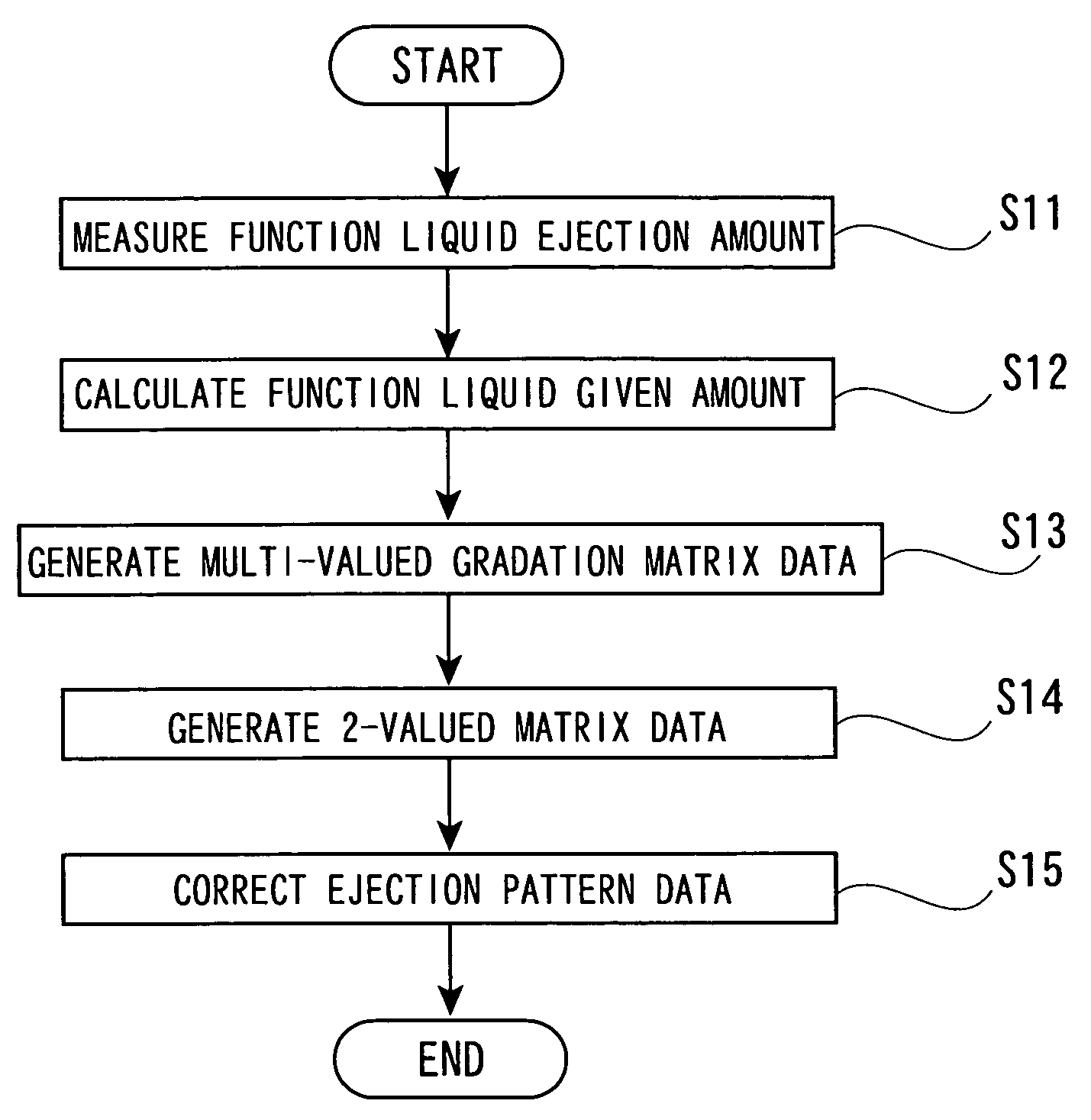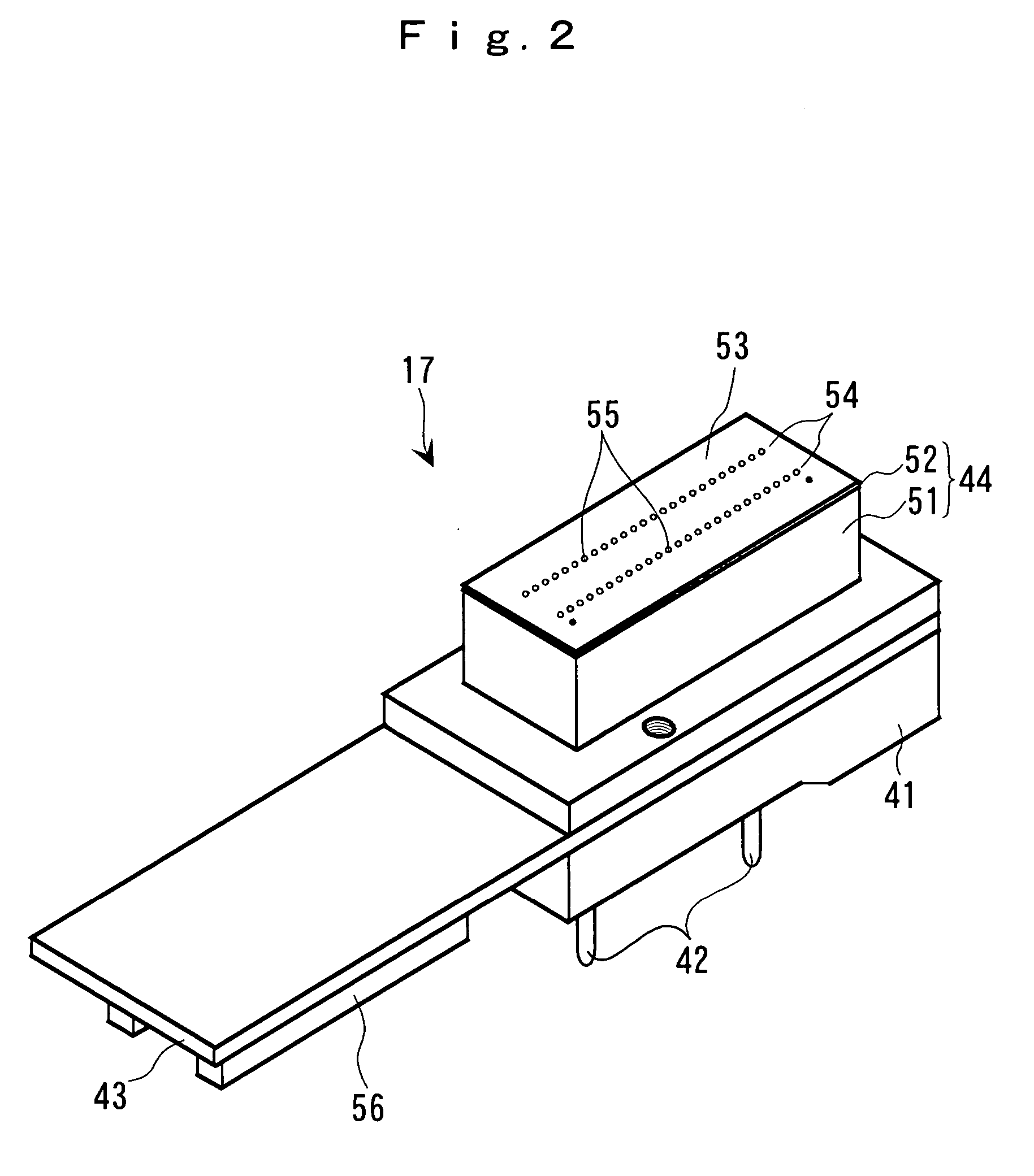[0007] It is an
advantage of the invention to provide a method of correcting ejection pattern data in which ejection pattern data can be corrected in such a manner that the viewer hardly realizes (notice) the drawing unevenness of a workpiece as a whole, as well as an apparatus for correcting ejection pattern data, a liquid droplet ejection apparatus, a method of manufacturing an electro-optic device, an electro-optic device, and an electronic device.
[0008] According to one aspect of the invention, there is provided a method of correcting ejection pattern data to eliminate drawing unevenness in drawing processing in which a function liquid droplet ejection head is moved relative to a workpiece to selectively eject function liquid droplets from a plurality of nozzles of the function liquid droplet ejection head according to ejection pattern data. The method comprises the steps of: calculating an amount of function liquid given in the drawing processing to each of a plurality of imaginary divided portions obtained by partitioning into matrix a drawing region on the workpiece; generating matrix data which represents in multi-valued
gradation an amount of function liquid given to the plurality of imaginary divided portions; processing
gradation by converting the matrix data into n-valued data to thereby generate n-valued matrix data, where n is an integer equal to or larger than 2; and correcting ejection pattern data so as to perform at least one of decreasing and increasing the amount of function liquid given to the imaginary divided portions. The amount is decreased where each of the n-valued data of the n-valued matrix data represents the side of “large,” and the amount is increased where each of the n-valued data of the n-valued matrix data represents the side of “small,” respectively, in the amount of function liquid given to the imaginary divided portions.
[0009] According to another aspect of the invention, there is provided an apparatus for correcting ejection pattern data to eliminate drawing unevenness in drawing processing in which a function liquid droplet ejection head is moved relative to a workpiece to selectively eject function liquid droplets from a plurality of nozzles of the function liquid droplet ejection head according to ejection pattern data. The apparatus comprises: a storing device for storing the ejection pattern data; a calculating device for calculating an amount of function liquid given in the drawing processing to each of a plurality of imaginary divided portions obtained by partitioning in matrix a drawing region on the workpiece; a data generating device for generating matrix data which represents in multi-valued gradation an amount of function liquid given to the plurality of imaginary divided portions; a gradation processing device to convert the matrix data into n-valued data to thereby generate n-valued matrix data, where n is an integer equal to or larger than 2; and a data correction device for correcting the ejection pattern data so as to perform at least one of decreasing and increasing the amount of function liquid given to the imaginary divided portions. The amount is decreased where each of the n-valued data of the n-valued matrix data represents the side of “large,” and the amount is increased where each of the n-valued data of the n-valued matrix data represents the side of “small,” respectively, in the amount of function liquid given to the imaginary divided portions.
[0010] According to these configurations, conversion into n-valued data is made of the matrix data based on the amount of function liquid given (or added) to each of the imaginary divided portions. As a result, the corrected ejection pattern data will adequately increase and / or decrease the amount of giving the function liquid to each of the imaginary divided portions. For example, suppose that matrix data is prepared by representing the amount of giving the function liquid in 10 stages from “0”, (function liquid giving amount: large) to “9” (function liquid giving amount: small) and that binarizing processing (i.e., conversion into 2-valued data) is performed. Then, in a region in which the function liquid giving amount is large, the 2-valued (binary) data in the imaginary divided portions partly becomes “0.” The amount of giving the function liquid for such imaginary divided portions is thereby decreased. The amount of giving the function liquid is thus decreased over the entire region in which the amount of giving the function liquid is large. The unevenness in drawing is eliminated, in this manner, in the workpiece as a whole. As a result, it is possible to correct the ejection pattern in such a manner that the viewer hardly realizes the unevenness in the workpiece as a whole.
[0011] In the above example, although a description was made about the binarizing processing, it is not necessary to limit the gradation processing to binarizing. Further, it is preferable that the number of gradation of the n-valued matrix data be set based on the adjustable number of the function liquid ejection amount per
one shot. For example, in case the amount of function liquid ejection per
one shot can be classed into large, medium, and small in shooting, the function liquid ejection amount may be 3-valued or further, by giving the case of no ejection, 4-valued.
[0012] It is preferable that, at the step of processing gradation, the n-valued matrix data be generated by conversion into n-valued data using one of a threshold value method, a systematic
dither method, and an
error diffusion (dispersion) method.
 Login to View More
Login to View More  Login to View More
Login to View More 


